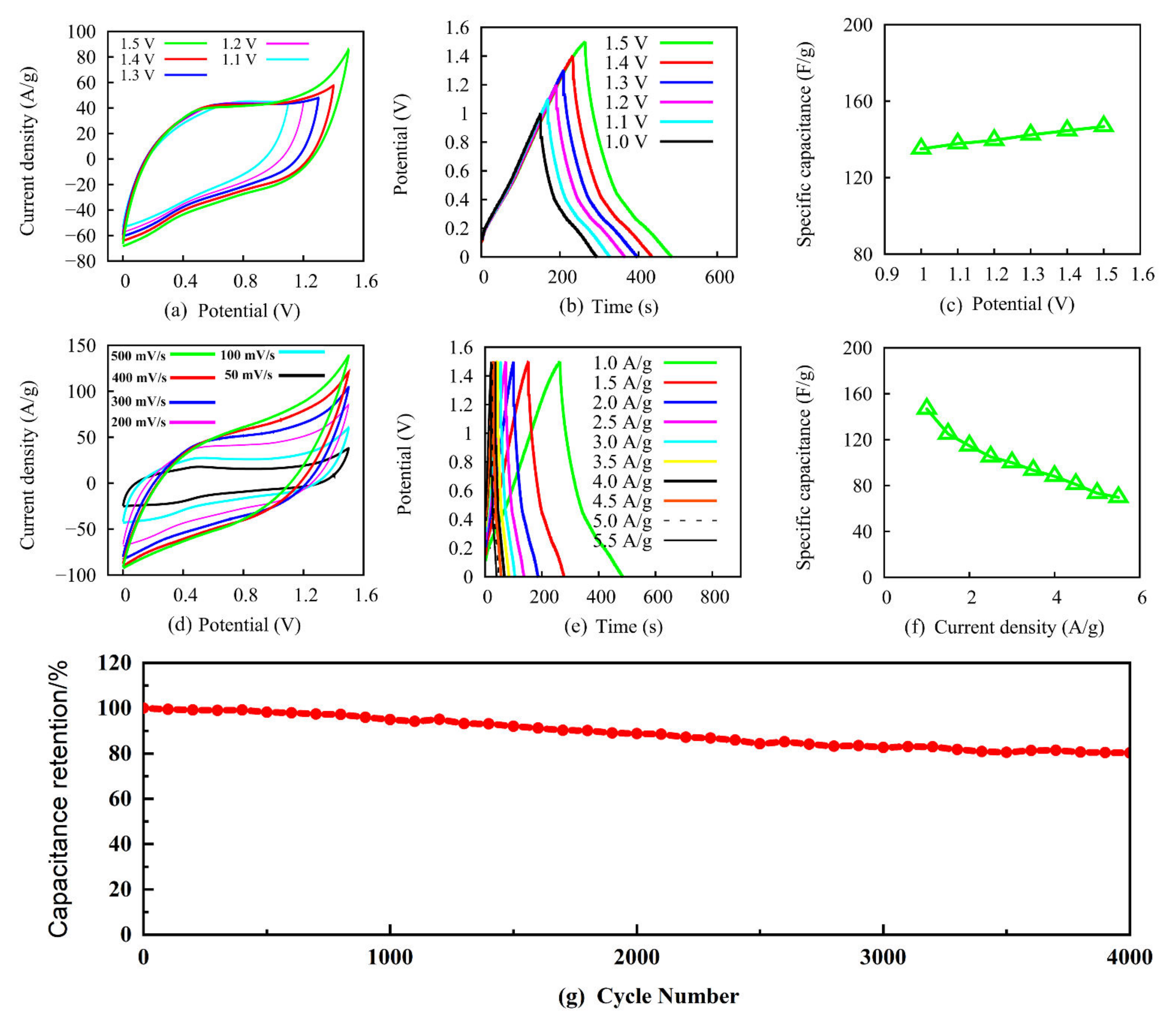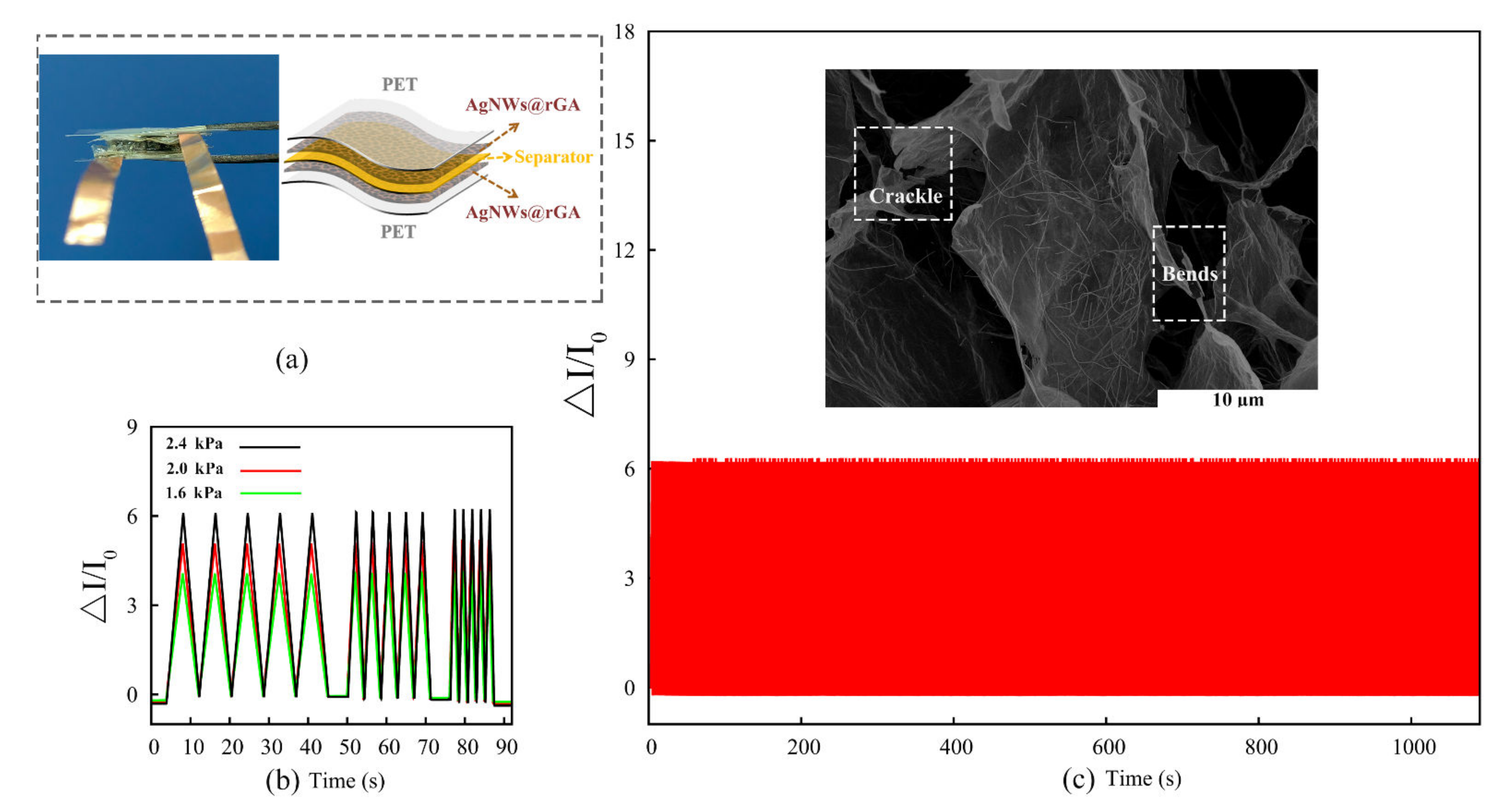Highly Compressible Elastic Aerogel Spring-Based Piezoionic Self-Powering Pressure Sensor for Multifunctional Wearable Electronics
Abstract
:1. Introduction
2. Experiments
2.1. Synthesis of Silver Nanowires@Reduced Graphene Aerogel
2.2. Preparation of Flexible Symmetrical Supercapacitor and Sensitive Piezoionic Self-Powering Sensor
2.3. Characterization
3. Results and Discussion
4. Conclusions
Author Contributions
Funding
Institutional Review Board Statement
Informed Consent Statement
Data Availability Statement
Acknowledgments
Conflicts of Interest
References
- Ahmed, A.; Sharma, S.; Adak, B.; Hossain, M.M.; LaChance, A.M.; Mukhopadhyay, S.; Sun, L.Y. Two-dimensional MXenes: New frontier of wearable and flexible electronics. InfoMat 2022, 4, e12295. [Google Scholar] [CrossRef]
- Xiao, Z.; Mei, Y.; Yuan, S.; Mei, H.; Xu, B.; Bao, Y.; Fan, L.; Kang, W.; Dai, F.; Wang, R.; et al. Controlled hydrolysis of metal–organic frameworks: Hierarchical Ni/Co-layered double hydroxide microspheres for high-performance supercapacitors. ACS Nano 2019, 13, 7024–7030. [Google Scholar] [CrossRef]
- Wei, N.; Tang, Y.; Li, Y.; Wang, Q.; Zeng, W.; Liang, D.; Wu, R. Metal–organic frameworks-derived hollow octadecahedron nanocages for supercapacitors and wearable self-powered tactile stress sensor. Appl. Surf. Sci. 2022, 599, 153822. [Google Scholar] [CrossRef]
- Liu, S.D.; Kang, L.; Zhang, J.; Jung, E.; Lee, S.C.; Jun, S.C. Structural engineering and surface modification of MOF-derived cobalt-based hybrid nanosheets for flexible solid-state supercapacitors. Energy Storage Mater. 2020, 32, 167–177. [Google Scholar] [CrossRef]
- Zhao, Y.; Cao, J.Y.; Zhang, Y.; Peng, H.S. Gradually Crosslinking Carbon Nanotube Array in Mimicking the Beak of Giant Squid for Compression-Sensing Supercapacitor. Adv. Funct. Mater. 2020, 30, 1902971. [Google Scholar] [CrossRef]
- Wang, L.N.; Tang, Y.X.; Li, Y.; Wei, N.; Yang, J. MXene/Silver Nanowire-Based Spring Frameworks for Highly Flexible Waterproof Supercapacitors and Piezoelectrochemical-Type Pressure-Sensitive Sensor Devices. Langmuir 2022, 38, 7312–7321. [Google Scholar] [CrossRef]
- Ge, G.; Cai, Y.C.; Dong, Q.C.; Zhang, Y.Z.; Shao, J.J.; Huang, W.; Dong, X.C. A flexible pressure sensor based on rGO/polyaniline wrapped sponge with tunable sensitivity for human motion detection. Nanoscale 2018, 10, 10033–10040. [Google Scholar] [CrossRef]
- Chen, S.C.; Wang, Y.F.; Yang, L.; Karouta, F.; Sun, K. Electron-Induced Perpendicular Graphene Sheets Embedded Porous Carbon Film for Flexible Touch Sensors. Nano Micro Lett. 2020, 12, 136. [Google Scholar] [CrossRef]
- Dong, X.C.; Wei, Y.; Chen, S.; Lin, Y.; Liu, L.; Li, J. A linear and large-range pressure sensor based on a graphene/silver nanowires nanobiocomposites network and a hierarchical structural sponge. Compos. Sci. Technol. 2018, 155, 108–116. [Google Scholar] [CrossRef]
- Wei, N.; Li, Y.; Tang, Y.; Zhou, Y.; Ning, R.; Tang, M.; Lu, S.; Zeng, W.; Xiong, Y. Resilient bismuthene-graphene architecture for multifunctional energy storage and wearable ionic-type capacitive pressure sensor device. J. Colloid Interface Sci. 2022, 626, 23–34. [Google Scholar] [CrossRef]
- Yu, Z.N.; McInnis, M.; Calderon, J.; Seal, S.; Zhai, L.; Thomas, J. Functionalized graphene aerogel composites for high-performance asymmetric supercapacitors. Nano Energy 2015, 11, 611–620. [Google Scholar] [CrossRef]
- Zhang, F.; Zang, Y.; Huang, D.; Di, C.-A.; Zhu, D. Flexible and self-powered temperature–pressure dual-parameter sensors using microstructure-frame-supported organic thermoelectric materials. Nat. Commun. 2015, 6, 8356. [Google Scholar] [CrossRef]
- Zhang, C.J.; Li, H.; Huang, A.M.; Zhang, Q.; Rui, K.; Lin, H.J.; Sun, G.Z.; Zhu, J.X.; Peng, H.S.; Huang, W. Rational Design of a Flexible CNTs@PDMS Film Patterned by Bio-Inspired Templates as a Strain Sensor and Supercapacitor. Small 2019, 15, 1805493. [Google Scholar] [CrossRef]
- Zheng, S.; Ma, J.; Fang, K.; Li, S.; Qin, J.; Li, Y.; Wang, J.; Zhang, L.; Zhou, F.; Liu, F.; et al. High-Voltage Potassium Ion Micro-Supercapacitors with Extraordinary Volumetric Energy Density for Wearable Pressure Sensor System. Adv. Energy Mater. 2021, 11, 2003835. [Google Scholar] [CrossRef]
- Lee, S.; Shin, S.; Lee, S.; Seo, J.; Lee, J.; Son, S.; Cho, H.J.; Algadi, H.; Al-Sayari, S.; Kim, D.E.; et al. Ag Nanowire Reinforced Highly Stretchable Conductive Fibers for Wearable Electronics. Adv. Funct. Mater. 2015, 25, 3114–3121. [Google Scholar] [CrossRef]
- Tang, H.H.; Feng, H.R.; Wang, H.K.; Wan, X.J.; Liang, J.J.; Chen, Y. Highly Conducting MXene–Silver Nanowire Transparent Electrodes for Flexible Organic Solar Cells. ACS Appl. Mater. Interfaces 2019, 11, 25330–25337. [Google Scholar] [CrossRef]
- Hu, S.; Han, T.; Lin, C.; Xiang, W.K.; Zhao, Y.H.; Gao, P.; Du, F.P.; Li, X.P.; Sun, Y.H. Enhanced Electrocatalysis via 3D Graphene Aerogel Engineered with a Silver Nanowire Network for Ultrahigh-Rate Zinc-Air Batteries. Adv. Funct. Mater. 2017, 27, 1700041. [Google Scholar] [CrossRef]
- Dong, Y.; Zhang, S.; Du, X.; Hong, S.; Zhao, S.N.; Chen, Y.X.; Chen, X.H.; Song, H.H. Boosting the Electrical Double-Layer Capacitance of Graphene by Self-Doped Defects through Ball-Milling. Adv. Funct. Mater. 2019, 29, 1901127. [Google Scholar] [CrossRef]
- Wei, N.; Wu, J.P.; Tang, Y.X.; Lu, S.B.; Wang, L.N. Self-powered supercapacitor-mode tactile sensor based on polygonal litchi–like nanospheres decorated three-dimensional reduced graphene oxide aerogel for wearable electronics device. J. Power Sources 2020, 479, 229096. [Google Scholar] [CrossRef]
- Yang, C.X.; Liu, W.J.; Liu, N.S.; Su, J.; Li, L.Y.; Xiong, L.; Long, F.; Zou, Z.G.; Gao, Y.H. Graphene Aerogel Broken to Fragments for a Piezoresistive Pressure Sensor with a Higher Sensitivity. ACS Appl. Mater. Interfaces 2019, 11, 33165–33172. [Google Scholar] [CrossRef]
- Yao, H.B.; Ge, J.; Wang, C.F.; Wang, X.; Hu, W.; Zheng, Z.J.; Ni, Y.; Yu, S.H. A Flexible and Highly Pressure-Sensitive Graphene-Polyurethane Sponge Based on Fractured Microstructure Design. Adv. Mater. 2013, 25, 6692–6698. [Google Scholar] [CrossRef]
- Shi, G.; Lowe, S.E.; Teo, A.J.T.; Dinh, T.K.; Tan, S.H.; Qin, J.D.; Zhang, Y.B.; Zhong, Y.L.; Zhao, H.J. A versatile PDMS submicrobead/graphene oxide nanocomposite ink for the direct ink writing of wearable micron-scale tactile sensors. Appl. Mater. Today 2019, 16, 482–492. [Google Scholar] [CrossRef]
- Rinaldi, A.; Tamburrano, A.; Fortunato, M.; Sarto, M.S. A Flexible and Highly Sensitive Pressure Sensor Based on a PDMS Foam Coated with Graphene Nanoplatelets. Sensors 2016, 16, 2148. [Google Scholar] [CrossRef] [Green Version]
- Huang, J.X.; Liu, X.H.; Yang, Z.G.; Wu, X.Z.; Wang, J.Q.; Yang, S.R. Extremely elastic and conductive N-doped graphene sponge for monitoring human motions. Nanoscale 2019, 11, 1159–1168. [Google Scholar] [CrossRef]
- Xu, M.X.; Li, F.; Zhang, Z.Y.; Shen, T.; Zhang, Q.; Qi, J.J. Stretchable and multifunctional strain sensors based on 3D graphene foams for active and adaptive tactile imaging. Sci. China Mater. 2019, 62, 555–565. [Google Scholar] [CrossRef] [Green Version]




| Material | Preparation Method | Sensitivity/GF | Detection Range | Stability | Refs |
|---|---|---|---|---|---|
| rGA | Solvothermal, freeze drying and high temperature annealing | 0.46 kPa−1 | 0.5–8 kPa | 4200 | [20] |
| RGO-PU-HT | Dip coating and hydrothermal reduction | 0.26 kPa−1 | 0201310 kPa | 10,000 | [21] |
| PDMS/EGO | Direct ink writing | 0.31 kPa−1 | 0.248–500 kPa | 1000 | [22] |
| GO/Ag NWs | Dip coating | 0.016 kPa−1 | 0–40 kPa | 7000 | [9] |
| MLG-PDMS | Drop casting | 0.23 kPa−1 | 10–70 kPa | - | [23] |
| NGS | Hydrothermal and thermal annealing | 1.33 kPa−1 | 30–40% (Strain) | 3000 | [24] |
| 3D GF | Self-assembly | 0.183 kPa−1 | 0–66 kPa | 10,000 | [25] |
| AgNWs@rGA | Self-assembly | 2.54 kPa−1 | 0–3.6 kPa | 1000 | This work |
Publisher’s Note: MDPI stays neutral with regard to jurisdictional claims in published maps and institutional affiliations. |
© 2022 by the authors. Licensee MDPI, Basel, Switzerland. This article is an open access article distributed under the terms and conditions of the Creative Commons Attribution (CC BY) license (https://creativecommons.org/licenses/by/4.0/).
Share and Cite
Wei, N.; Li, Y.; Zhu, C.; Tang, Y. Highly Compressible Elastic Aerogel Spring-Based Piezoionic Self-Powering Pressure Sensor for Multifunctional Wearable Electronics. Nanomaterials 2022, 12, 2574. https://doi.org/10.3390/nano12152574
Wei N, Li Y, Zhu C, Tang Y. Highly Compressible Elastic Aerogel Spring-Based Piezoionic Self-Powering Pressure Sensor for Multifunctional Wearable Electronics. Nanomaterials. 2022; 12(15):2574. https://doi.org/10.3390/nano12152574
Chicago/Turabian StyleWei, Ning, Yan Li, Chunqin Zhu, and Yuxi Tang. 2022. "Highly Compressible Elastic Aerogel Spring-Based Piezoionic Self-Powering Pressure Sensor for Multifunctional Wearable Electronics" Nanomaterials 12, no. 15: 2574. https://doi.org/10.3390/nano12152574






